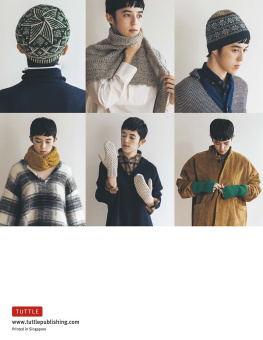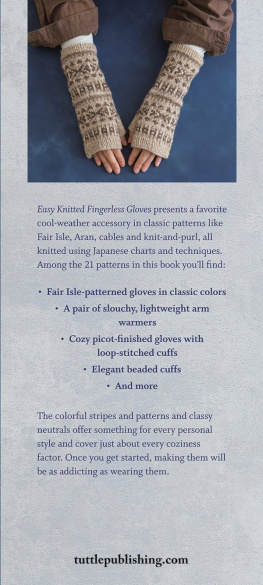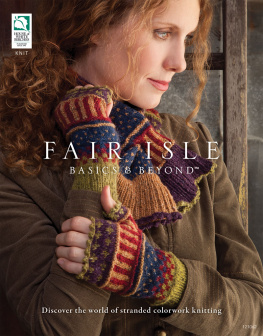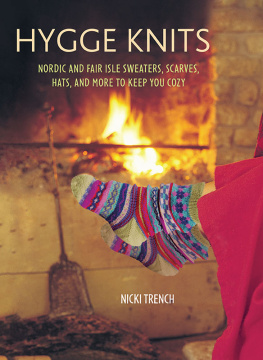SpillyJane, a.k.a. Jane Dupuis
Originating in Fair Isle, a tiny island in the northernmost archipelago (Shetland) of the British Isles, Fair Isle knitting has been produced continuously for two hundred years or more. As popular today as ever, Fair Isle knits are routinely present on the high-fashion runways of Paris and New York. This seemingly complex colorwork knitting is surprisingly simple to create and great fun for the knitter.
True Fair Isle knitting never uses more than two colors in any row, yet it achieves fantastic color effects from elegantly subtle shadings to wild riots of color. If youre new to the technique, begin with a simple project that uses just a touch of colora two-color band that encircles a cowl, for exampleand work your way up to a more complex color arrangement that includes many colors in the same pattern motif. Whatever your wish, these patterns offer enticing choices for every skill level.
After you have taken in the twenty designs, turn to the Design Notebook where youll find a discussion of the basics of Fair Isle knitting, including holding and managing two yarns, dealing with floats, and combining colors successfully. The seemingly terrifying technique of steeking is also clearly explained and will put your fears to rest.
Dont worry if youre new to Fair Isle knitting. At the end of the book youll find a glossary of terms and techniques that includes illustrated instructions for all the specific techniques mentioned in the projects. Along with easy-to-follow directions and clear illustrations in the project and design chapters, this glossary will provide all the help you need to successfully complete any project in this book.
Whats in a Name?
The names of many of the garments in this book contain words from Shetland dialect, a language that is very much alive today. There are several online sources to learn more about Shetland dialect, and it is from these sites that the words were mined. Apologies if any words are misused.
hap (n): handknitted shawl ().
kelliemuff (n): a mitt ().
ketlin (n): kitten ().
kulli (n): cowl ().
mareel (n): phosphorescence in the sea at twilight or dark, e.g., from oar tips ().
mayflooer (n): Primula, a flower that blooms in May ().
mirknin (n): dusk, twilight ().
mirry-dancers (n): northern lights, aurora borealis ().
morroless (adj): unmatched, odd ().
peerie weerie (adj): very, very small ().
sukkalegs (n): stockings without feet ().
valenzi (n): violent gale ().
SOURCES
Shetland for Wirds
shetlanddialect.org.uk/dictionary
You can listen to the spoken language here.
Angus, James Stout. A Glossary of the Shetland Dialect. 1914.
Available online at: http://archive.org/details/cu31924026538979.

Kulli Cowl
DESIGNED BY YSOLDA TEAGUE
A cowl makes a wonderful introduction to Fair Isle knitting, and the one Ysolda Teague designed is interesting enough to enchant even experienced knitters. Bands of solid-color garter stitch cleverly worked in the round alternate with a series of sweet peerie (small) patterns for a deceptively complicated impression of color and texture. To keep the piece light and airy, Ysolda chose a fingering-weight alpaca that she worked at a fairly loose gauge. She followed a traditional color palette of golden yellow that contrasts with rich madder red paired with a pale natural gray, but the overall effect is strictly modern.
FINISHED SIZE
About 34" (86.5 cm) circumference and 9" (23 cm) tall, blocked.
YARN
Laceweight (#0 Lace).
Shown here: Isager Alpaca 1 (100% baby alpaca; 437 yd [400 m]/50 g): #3 old gold (MC), #21 red (CC1), and #2s light natural gray (CC2), 1 ball each.
NEEDLES
Single-color rnds: size U.S. 2 (2.75 mm): 24" (60 cm) circular (cir).
Fair Isle rnds: size U.S. 3 (3.25 mm): 24" (60 cm) cir.
Adjust needle size if necessary to obtain the correct gauge.
NOTIONS
Stitch marker (m); tapestry needle.
GAUGE
28 sts and 56 rnds = 4" (10 cm) in garter stitch, worked in rnds with smaller needle, after blocking.
stitch guide
Garter Stitch in Rounds without Purling
Note: In this pattern, other strand refers to the strand of yarn not used for the previous round. On the very first round, you may use either strand.
Rnd 1: With RS facing, pick up the other strand of MC, knit to end of rnd, then turn piece so WS is facing, drop yarn.
Rnd 2: With WS facing, pick up other strand of MC and knit to end of rnd, turn piece so RS is facing, drop yarn.
Rep Rnds 1 and 2 for pattern.
notes
- All solid and charted rounds using CC1 and CC2 are worked in stockinette in the round with the RS of the work always facing you.
- If you are working from a center-pull ball of MC, take the two strands used for working garter stitch in the round without purling (see above) from the inside and outside of the same ball. Allow the center-pull ball to dangle from the work to untwist strands when necessary.
Cowl
With CC1 and CC2 held tog and smaller needle, CO 240 sts. Cut yarns. With RS facing, join 2 strands of MC, then drop 1 strand.
Rnd 1: Working each double CO st as a single st, work Rnd 1 of garter st in rnds without purling (see ), turn work so WS is facing, place marker (pm), and join for working in rnds.
Rnds 212: Work Rnd 2 of garter st in rnds, then rep Rnds 1 and 2 five more times.
Cut both strands of MC.
Rnd 13: Join CC1 and knit 1 rnd.
Rnds 1418: Change to larger needle. Join CC2 and work Rnds 15 of Chart A.
Cut CC2.










